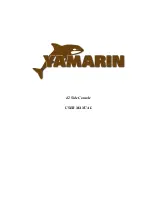
Section 06 ENGINE MANAGEMENT (RFI)
Subsection 03 (COMPONENT INSPECTION )
COMPONENT INSPECTION
GENERAL
WARNING
The fuel system of a fuel injection system
holds much more pressure than on a car-
bureted watercraft. Prior to disconnecting
a hose or to removing a component from
the fuel system, follow the recommendation
described here.
– Always disconnect battery properly prior to
working on the fuel system.
WARNING
Fuel lines remain under pressure at all times.
Always proceed with care and use appro-
priate safety equipment when working on
pressurized fuel system. Wear safety glasses
and work in a well ventilated area. Do not
allow fuel to spill on hot engine parts and/or
on electrical connectors. Proceed with care
when removing installing high pressure test
equipment or disconnecting fuel line connec-
tions. Cover the fuel line connection with an
absorbent shop rag. Slowly disconnect the
fuel hose to minimize spilling. Wipe off any
fuel spillage in the bilge. Fuel is flammable
and explosive under certain conditions. Al-
ways work in a well ventilated area. Always
disconnect battery prior to work on the fuel
system. After performing a pressure test,
use the valve on the fuel pressure gauge to
release the pressure (if so equipped).
When the job is done, ensure that hoses from fu-
el rail going to fuel pump are properly secured in
their support. Then, pressurize the fuel system.
Perform the high pressure test as explained in this
section and pressurize the fuel tank and fuel lines
as explained in FUEL SYSTEM section.
Properly reconnect the battery.
WARNING
Ensure to verify fuel line connections for
damage and that NO fuel line is disconnected
prior to installing the safety lanyard on the
DESS post. A pressure test must be done
before connecting the safety lanyard. The
fuel pump is started each time the safety lan-
yard is installed and it builds pressure very
quickly.
CAUTION:
Never use injector cleaning prod-
ucts. They may contain additive that could
damage injector components. A copper wire
brush may be used to clean the tip of the direct
injectors if necessary.
Engine problems are not necessarily related to the
electronic fuel injection system.
It is important to check that the electrical system
is functioning properly:
– battery
– fuses
– DESS
– ignition (spark)
– ground connections
– wiring connectors.
If all of the above mentioned items are function-
ing correctly, the following verifications can be per-
formed to detect any faulty components.
NOTE:
Troubleshooting should be performed
using the VCK or MPEM programmer tool. See
TROUBLESHOOTING in this subsection.
It is possible that a component seems to operate
in static condition but in fact, it is defective. In
this case, the best way to solve this problem is
to remove the original part and replace it with one
which is in good condition.
Never use a battery charger to replace temporari-
ly the battery, as it may cause the MPEM to work
erratically or not to work at all. Check related-cir-
cuit fuse solidity and condition with an ohmmeter.
Visual inspection could lead to false results.
smr2004-Complete Line Up
307
www.SeaDooManuals.net
Содержание 2006 GTI
Страница 1: ...Smr 2004 ang FH8 Thu Jun 03 14 42 10 2004 Page 1 www SeaDooManuals net ...
Страница 183: ...Section 04 ENGINE 2 STROKE Subsection 06 ROTARY VALVE F01D73W 159 smr2004 Complete Line Up 161 www SeaDooManuals net ...
Страница 795: ...F17Z03 www SeaDooManuals net ...
Страница 796: ...F17Z05 www SeaDooManuals net ...
Страница 797: ...F17Z04 www SeaDooManuals net ...
Страница 798: ...F17Z06 www SeaDooManuals net ...
Страница 799: ...F08Z03 www SeaDooManuals net ...
Страница 800: ...F18Z1A www SeaDooManuals net ...
Страница 801: ...Smr 2004 ang FH8 Thu Jun 03 14 42 10 2004 Page 1 www SeaDooManuals net ...
















































